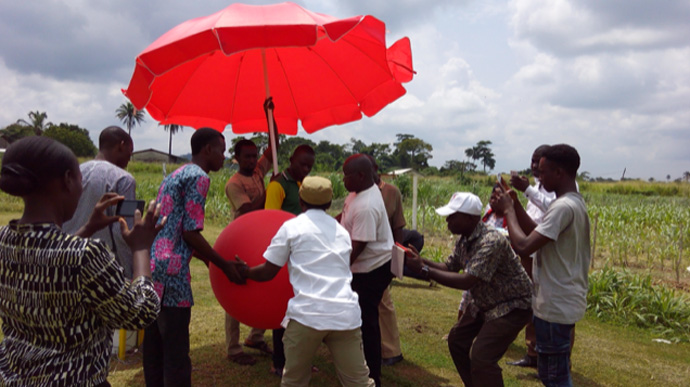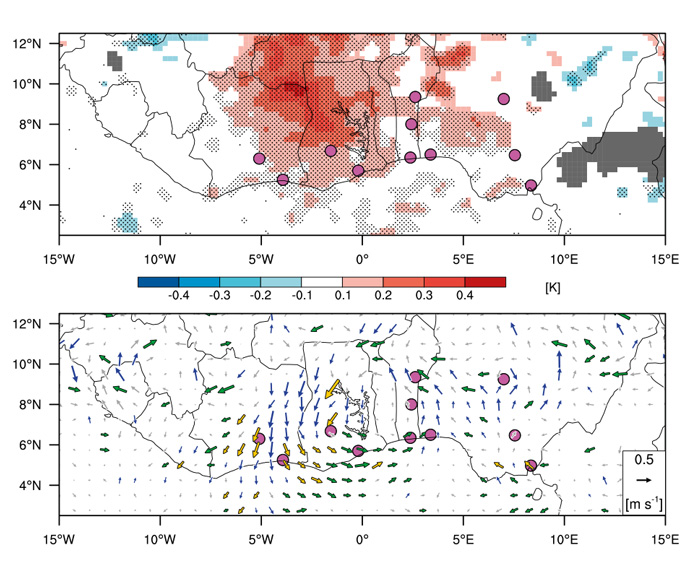 |
 |
|
 |
 |
Top row: Angela Benedetti, ECMWF Senior Scientist, Earth System Assimilation Section and Peter Knippertz, Professor of Meteorology, Karlsruhe Institute of Technology
Bottom row: Andreas Fink, Professor, Karlsruhe Institute of Technology and Bruce Ingleby, ECMWF Senior Scientist, Earth System Assimilation
Over five years from 2013 to 2018, the DACCIWA project (Dynamics-Aerosol-Chemistry-Cloud Interactions in West Africa, funded by the EU) worked with partners in the region to improve understanding of the meteorology and air quality of West Africa (see Knippertz et al., 2015).
The region is heavily dependent on precipitation from the West African monsoon. However, a lack of observations and an incomplete understanding of the way aerosols, clouds, radiation and regional circulations interact, is hampering accurate predictions of the monsoon and its subsequent impacts.
A key element of the DACCIWA project was a major field campaign in densely populated southern West Africa in summer 2016, involving three research aircrafts and a wide range of surface-based instrumentation at three sites in Ghana, Benin and Nigeria.
DACCIWA produced the most comprehensive observational dataset of the atmosphere over the region to date (see Flamant et al., 2018) and used this dataset to foster our understanding of atmospheric processes, and to evaluate dynamical models and satellite data.
ECMWF has been an active partner in the project, providing operational forecast data for the field campaign, as well as research aimed at understanding the forecast skill in West Africa. In particular, ECMWF’s involvement has focused on the West African monsoon and the role of aerosols on predictability at the sub-seasonal to seasonal timescale, both at the regional and the global level.
The project was coordinated by Peter Knippertz from the Karlsruhe Institute of Technology and involved many partners across Europe and West Africa.
The challenges of organising the DACCIWA field campaign
Organisation of the large international DACCIWA field campaign turned out to be a real logistical challenge. The whole endeavour had to be postponed by one year to 2016 due to the Ebola epidemic in West Africa in 2014/2015.
Flying three research aircraft around the region, setting up and running three observational supersites in Ghana, Benin and Nigeria in the warm and humid conditions of monsoonal Africa and launching more than 700 radiosondes in four different countries was an extraordinary organisational challenge. Many permissions were only obtained at the very last minute, in some cases only when containers with equipment were already on their way to Africa.
Due to the delay in the campaign timing, the main British research aircraft had to be replaced by a smaller one designed to fly in Antarctica. This created additional challenges in terms of moving instruments between platforms and, as the plane was designed for polar campaigns, some rather hot conditions in the cabin during flight operations!
Interactions with African partners were the real gem of the project: DACCIWA trained several African PhD students and interacted with many African organisations. For example, forecasters from the Togolese weather services were involved in daily weather discussions and flight planning at the main aircraft base in Lomé. Radiosonde launches were a highlight for our African colleagues and were sometimes even accompanied by a cheering crowd (Figure 1), particularly in places where currently no operational launches are being done.

Figure 1: Radiosonde launches during the DACCIWA field campaign sometimes drew a cheering crowd!
DACCIWA also organised workshops in African capitals and in Brussels to communicate the project results to policymakers and other interested parties.
The rich dataset from the observational campaign was quality controlled and uploaded to the DACCIWA database, where it is freely available to the scientific community.
The analysis of observations got into full swing over the latter years of the programme – providing a solid foundation for improved understanding, modelling and monitoring of the atmosphere over southern West Africa.
Lessons learned
Recently a document has been published by the DACCIWA team, led by Prof Peter Knippertz (KIT), titled: “Key lessons from the DACCIWA project for operational meteorological services”, which summarises the most significant results of the research and offers recommendations to improve the quality of the forecasts for this region.
Understanding model errors
Overall, the meteorological forecasts from ECMWF and other centres were useful for planning during the campaign, particularly when synoptic-scale vortices were present, leading to organised circulation and convective rainfall. Low clouds tended to be underestimated by weather and climate models leading to too much solar radiation at the surface. Individual convective systems were often missed or incorrectly located. A more realistic representation of convection would help improve medium-range forecasts, both over the region and the adjacent extratropics, including Europe.
Bruce Ingleby (ECMWF) was involved in assimilating the observations from the unprecedented DACCIWA radiosonde dataset into the ECMWF model (see van der Linden et al., 2020). This work showed a lower-tropospheric dry bias in parts of southern West Africa during the summer monsoon. The ECMWF model also showed a general cold bias, most likely due to too strong cold advection from the Gulf of Guinea during the night (Figure 2). Analysis and forecast improvements due to better observations were moderate, pointing to the need to improve the model performance over the area for more skilful forecasts.

Figure 2: Early morning (06 UTC) 925 hPa temperature bias (top) and night-time (00 UTC) 925 hPa vector wind bias (bottom) calculated as the mean differences between the “DACCIWA” and “noDACCIWA” analyses during 15 June to 31 July 2016. Stippling highlights regions with statistically significant differences. Only every third vector is shown. Colours of vectors indicate statistical significance of vector differences: blue vectors where only meridional component is significant, green vectors where only zonal component is significant, yellow vectors where both components are significant and grey vectors where no component is significant. Regions where the 925 hPa pressure level lies below orography are not plotted. The filled circles indicate the locations of the radiosonde stations. (Figure after van der Linden et al. 2020.)
Critical processes suspected of contributing to the model errors were identified:
- warm process rain and drizzle frequently occur in southern West Africa during the summer monsoon season and impact on cloud lifetime and the vertical distribution of moisture;
- convective organisation is a key element of the meteorology of southern West Africa and this creates large sensitivities to model resolution;
- African easterly waves and Kelvin waves considerably modulate rainfall and need to be better represented.
The impact of aerosols on the atmosphere
The comprehensive dataset collected by DACCIWA also helped to establish how both the locally emitted aerosols and those transported from other regions (for example biomass burning from Central Africa) influence the atmosphere. It was found that the impact is mostly realised through radiative processes, and less through cloud microphysical effects, with an important role for water uptake by aerosol particles. The radiative effect of aerosol was found to delay the daytime stratus-to-cumulus transition, the progression of the coastal front and convective triggering, leading to more intense storms but less rainfall overall.
A study conducted by Angela Benedetti (ECMWF) on the interactive representation of dust and biomass burning aerosol from central Africa, showed the potential to improve sub-seasonal predictions both regionally over West/Central Africa and globally, in line with what was found in Benedetti and Vitart (2018). See Figure 3, where dark blue circles show a statistically significant improvement with prognostic aerosols. The orange circles (which show a degradation in performance) are not statistically significant.

Figure 3: Scorecard for an experiment with prognostic aerosols (PROG2) compared to one using an aerosol climatology (CONTROL1), both started on 01 May. Blue indicates an improvement in skill with prognostic aerosols, orange/red indicates a reduction in skill. w1 corresponds to forecast days 5–11, w2 to 12–18, w3 to 19–25 and w4 to 26–32. Verified variables are total precipitation (tp), 2m temperature (t2m), surface temperature (stemp), sea-surface temperature (sst), mean sea level pressure (mslp), temperature (tX), zonal wind (uX), meridional wind (vX), streamfunction (sfX) and velocity potential (vpX), where X is the respective pressure level in hPa. Twelve years of re-forecasts with 50 ensemble members of the ECMWF system were analysed. Adapted from Benedetti and Vitart (2018).
Providing recommendations to stakeholders
Based on all the observations collected during DACCIWA and all the excellent science that was produced by the team, some final recommendations were made to operational stakeholders (e.g. national and regional weather services, and space agencies).
Firstly, there is an urgent need to sustain and expand networks of meteorological surface and radiosonde stations in a region notoriously sparse of observations. Data should generally adhere to international standards, be shared freely and be used to evaluate and develop satellite products, which were shown by DACCIWA to have substantial, region-specific issues.
Secondly, there is a need to improve numerical models taking into account identified key processes. This includes aspects such as experiments with convection-permitting resolution, inclusion of interactive aerosol, cost-benefit analysis of sophisticated cloud microphysics, and evaluation of the coupled diurnal evolution of the boundary layer and low clouds.
The five years of DACCIWA have been a fantastic, exciting and rewarding time and the many researchers involved in the project have significantly advanced what we know about the air quality, weather and climate of southern West Africa.
